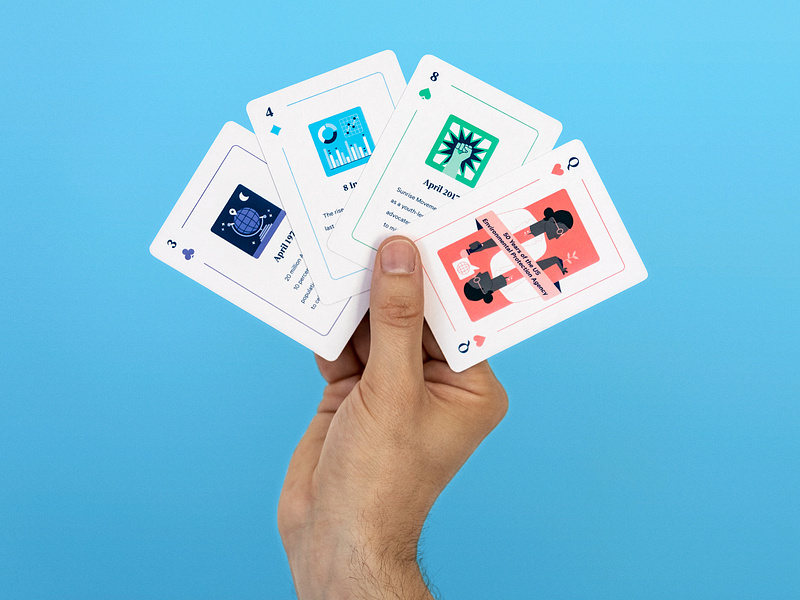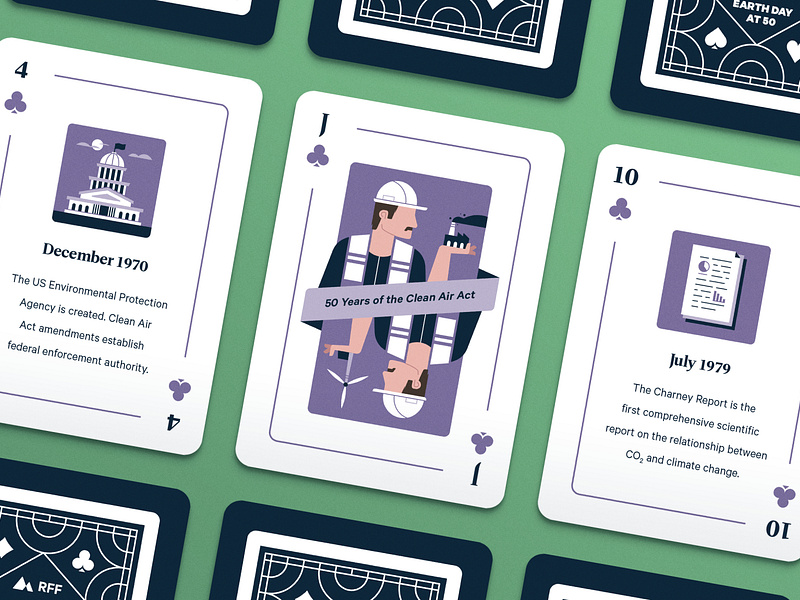Independent Graphic Designer & Illustrator James Round joins us on the blog today to share five tips and best practices for designing beautiful playing card decks!
I recently worked with the folks over at Resources for the Future on a deck of playing cards to celebrate the 50th anniversary of Earth Day. They wanted to include a gift with the latest issue of their magazine, Resources , that explored some notable moments in environmental history since the first Earth Day. A pack of playing cards provided over 50 little canvases to do just that!
I’ve worked on a couple of playing cards projects over the last few years, and found that it’s the basis for an amazing project, with a big scope for creativity and a really satisfying end result. For brands, they provide the opportunity to communicate insights in interesting and playful ways, and for a personal project, they allow the exploration of a theme or idea in a unique but sometimes challenging format.
Fancy making your own? Here are five tips for creating a beautifully bespoke deck of playing cards.
1. Don’t be daunted
Staring at an Adobe Illustrator document featuring over 50 blank artboards can be a frightful sight for any designer! However, while it’s certainly a substantial undertaking, it’s also surprising how fast things start to come together.
The overall layout of the cards is likely to be the same throughout the deck, and even face cards can be given the same basic structure which is then tweaked to create each unique design. You can also take shortcuts and reuse certain elements—not every card has to be completely unique to produce a compelling and varied result. Finally, when approaching a project like this, it’s helpful to work with a style you feel comfortable with, which you can produce quickly and with confidence.

James Round (for Human After All)
2. Gather inspiration
Once you begin to explore the world of playing card design, you’ll quickly realize what an incredibly visual medium it is. Just look at this beautifully crafted deck for the US Postal Service by Jay Fletcher. Or this wonderfully stylish set by DKNG. Or the exceptional use of patterns in this deck by LA-based creative team, TRÜF.
There’s a huge scope for creative expression. And because we have an expectation of what a pack of playing cards should look like, we can surprise and delight people with a careful subversion of those expectations through impactful design.

3. Keep some standards in mind
Even though there’s plenty of opportunity to add value to the cards through customization, it’s important to be mindful of the standards of good card design—after all, you want people to be able to use them.
Make sure the numbers are clear and consistent, and keep the suit symbols as the hearts, diamonds, clubs, and spades that people would expect to see. And while I think it’s fine to move away from the standard red and black seen in a standard deck, ensure that each of your suits has a strong key color. Lastly, while you can really make the cards any size you want, if you’re looking to build upon the design of a traditional deck, you’re probably going to want to use the dimensions of a standard poker card (2.5” x 3.5”).

James Round (for Human After All)
4. Software shuffle
When designing playing cards, I create the visual elements in Adobe Illustrator, and then flow the artwork into an InDesign file where I add in the copy. This plays to the strengths of each application, specifically using InDesign’s master pages and type styling capabilities—allowing you to make updates across the entire deck quickly and easily.
Be conscious that a playing card is a small canvas, so it’s important that both your type and artwork is clear and legible at that size. And remember that playing cards have rounded corners, so add a guide over your artwork to reflect this, and make sure none of the content is creeping too close.

5. Consider the full experience
We’ve seen that playing cards offer tons of opportunity for creativity—but it doesn’t stop with the suits and face cards. Don’t forget about the jokers, card backs and box! These are all just waiting for some creative flourish. The card backs and box are both perfect for an interesting pattern, which can be full of references to the theme of your cards. And the jokers are a great place to inject a little bit of humor.
Finally, as with any printed product, the design doesn’t end with finished artwork, and your playing cards can be elevated by the material they’re printed on–aim for something above 300gsm with a little bit of texture and a plastic coating for durability, and you’ll have a heck of a deck.

![]() Want to keep up with James? Find him on Dribbble and check out his other authored posts on Courtside — Mastering Data Visualization: 3 Tips For A Smoother Design Process and How to use data visualization to tell a compelling story.
Want to keep up with James? Find him on Dribbble and check out his other authored posts on Courtside — Mastering Data Visualization: 3 Tips For A Smoother Design Process and How to use data visualization to tell a compelling story.
Find more Process stories on our blog Courtside. Have a suggestion? Contact stories@dribbble.com.











